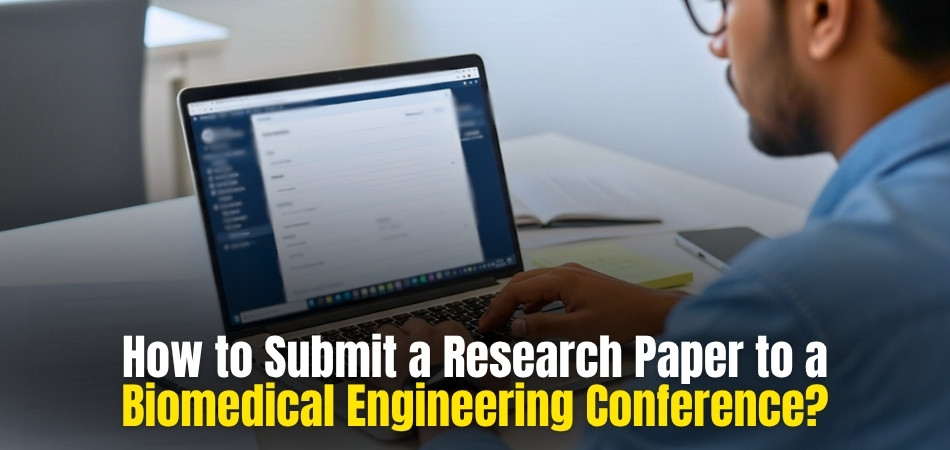Biomedical engineering conferences are exciting events where people share new inventions and smart ideas to help improve healthcare. If you’ve worked on something useful and want others to see it, submitting a research paper is a great step. Now you may ask, how to submit a research paper to a biomedical engineering conference?
To submit a research paper to a biomedical engineering conference, pick the right event that matches your topic. Read the rules carefully, write your paper clearly, and include charts if needed. Ask someone to review it, then upload it on the conference website. Wait for their reply, and if accepted, get ready to present your work.
Are you wondering how to pick the right conference or what to do after submitting your paper? Keep reading—this article will guide you through every step in a simple and easy way.
How to Submit a Research Paper to a Biomedical Engineering Conference?
If you’ve worked on something interesting in biomedical engineering and want others to know about it, sending your paper to a conference is a great move. It might seem a little complicated at first, but don’t worry. You don’t need to be a genius to do this. You just need to follow a few simple steps. Let’s look at how you can do it:

Choose the Right Conference
To begin, find a biomedical engineering conference that is relevant to your topic. Some focus on devices, others on medical research or tech tools. If you’re looking at big events, like conferences in USA, Canada, or the UK, make sure your topic matches what they want. Read what the conference is all about and what kind of papers they are looking for. Also, note down the deadline and check all the other details on their official website.
Know the Rules
Each conference has its own rules for sending papers. These rules tell you how many pages the paper should be, which format to use, and where to send it. If you don’t follow the rules, your paper might not even get looked at. You can usually find the rules clearly listed on the website. It’s smart to read them fully before you start writing anything.
Write the Paper
Start with a title and a brief summary that explains your main point. Talk about the problem you worked on and how you found a way to solve it. Write in a clear and simple way so people can easily understand what you mean. Use short sentences and avoid big, confusing words. Add drawings, charts, or pictures if they help explain things better.
Ask for Help
It’s perfectly fine to get help while working on your paper. Ask someone to read it and give advice or fix any small mistakes. They might see something you missed or suggest a better way to say something. You can also look at papers from past conferences to get an idea of what works well. Even small bits of advice can make your paper much better.
Submit the Paper
When your paper is ready, go to the conference website and find the page where you submit it. You’ll need to type in your name, the paper title, and maybe a short summary. Then upload your paper file and check that everything is correct. Once you send it, you should get a message or email saying they received it. Make sure to keep that message safe.
Wait for Reply
After you submit your paper, a group of people will read it and decide if it fits the conference. This part can take a few weeks. So don’t worry if you don’t hear back right away. If your paper doesn’t get accepted, that’s okay—you can always try again or fix it and send it to another conference. If it gets accepted, they’ll tell you what to do next.
Share Your Work
If your paper is accepted, you might be asked to present it at the conference. You can make a slideshow or a short talk to explain your work. It’s a fun way to show others what you did and why it matters. You’ll also meet people who are interested in the same things. Don’t be nervous—just enjoy the chance to share your idea.
What to Revise Before Submitting Your Biomedical Engineering Conference Paper?
Before you hit submit on your biomedical engineering paper, there’s one last thing to do—revise. Even a strong paper can get better with a bit of editing. Small changes often make a big difference. Here is what to check before sending it out.
Fixing Small Mistakes
Typos and grammar errors can make even a great paper look messy. Look for missing words, wrong punctuation, or anything that sounds confusing. Reading your paper out loud can help you catch mistakes. If something doesn’t sound right, it probably needs fixing. Double-check everything, even if you’ve looked at it before.
Checking Technical Parts
Every detail in a biomedical paper should be correct. If you’re talking about numbers, tools, or test results, they must match what you’ve done. Wrong info here can confuse the people reading your paper. That’s why careful attention to data consistency and technical accuracy plays a major role in improving biomedical engineering conference paper quality, especially before final submission. A second look really helps avoid small but serious mistakes.
Making It Clear
Your paper should be easy to understand, not just for experts but for anyone reading it. If something feels too long or hard to follow, break it into smaller parts. Short sentences are your friend. Use everyday words when possible, and explain any terms that might not be clear to others. The goal is to make your ideas easy to follow.
Getting a Second Opinion
Once you’ve done your part, let someone else take a look. Another person can see things you might have missed. They can also tell you if something doesn’t make sense or feels confusing. Even a few small comments from a friend or teacher can make the paper better. Honest feedback always helps clean up your work.
Reviewing the Structure
The order of your paper matters a lot. Make sure everything is in the right place—from the title and summary to the conclusion. Each section should connect well to the next. If something feels out of order or doesn’t flow smoothly, move it around until it feels right. A well-organized paper is easier to read and more enjoyable to follow.
Improving the Look
A good-looking paper is easier to read. Make sure the fonts, line spacing, and headings all look neat and are the same throughout. Check if the images or charts are clear and labeled properly. Use bold or italic text only when it really adds meaning. Keeping the design clean helps people focus on your ideas.
Checking the Guidelines
Every conference has its own rules, so it’s super important to follow them exactly. Check the paper length, the file format, and how to upload it. Even if your paper is great, not following the rules can get it rejected. Read the instructions one more time and match your paper with what they ask for. It’s always worth the extra few minutes.
Common Research Paper Submission Guidelines in Biomedical Engineering Conferences
Submitting a research paper to a biomedical engineering conference requires more than just writing. You also need to follow specific rules. These guidelines help make sure everything is fair and easy to understand for reviewers.
- Paper Length Limit: Most conferences set a page limit to keep reviews fair. Going over the limit may lead to automatic rejection without any review.
- Format and Template: You must use the official paper template provided on the conference website. It covers margins, font size, and section headings clearly.
- Abstract Requirement: An abstract is needed at the beginning of your paper. It gives a short summary of your work and key findings.
- File Type and Size: Many conferences only accept PDF files within a certain size limit. Large or wrong file types can cause upload problems quickly.
- Language and Style: Papers must be written in clear English using proper grammar. Keep your tone simple and formal without slang or personal language.
- Reference Style: All references should follow the required citation format. Common styles include IEEE, APA, or specific formats set by the conference.
- Original Work Only: Your paper must be your own work, not copied from somewhere else. Submitting the same paper to multiple places is not allowed.
- Deadline Rules: Late submissions are usually not accepted. Always check the deadline and try to submit a day or two before the cutoff.
What Are Some Ways to Choose the Right Biomedical Engineering Conference for Your Research Paper?
Picking the right biomedical engineering conference for your research paper can feel confusing at first. There are many options out there, and each one is different in its own way. Some are better for certain topics, while others are more general. Read on to discover simple tips for picking the best one.
Know Your Topic
Before choosing a biomedical engineering conference, it’s important to find a topic for a biomedical engineering conference paper that clearly shows what your research is about. Is it about medical devices, body sensors, or maybe tissue design? When you know your exact topic, it becomes easier to match it with the right conference. This way, your paper will go to a place where people truly care about what you wrote.
Check Conference Themes
Every biomedical engineering conference has a theme or focus. Some may be all about new tools, while others talk more about science inside the body. Read their themes carefully to see if they match your paper. If your topic doesn’t fit, it’s better to skip that one and look for another.
Look at Past Events
Visit the conference website and see what kind of papers were shared before. You’ll get an idea of the level and style of work they accept. If your topic is similar to what they’ve shown before, that’s a good sign. Also, check how often the event happens and how big it usually is.
See Who Attends
It’s useful to know who usually goes to the biomedical engineering conference. If experts and professionals in your field attend, it means your work will be seen by the right people. Some events are more focused on real-world tools, while others are more about research. Choose the one that matches your goal.
Check Paper Rules
Different biomedical engineering conferences ask for different things. Some want short papers, while others want long ones. Read the instructions to see if you’re ready to follow their rules. If the rules feel too hard or confusing, it may be better to try a different one.
Think About Deadlines
Make sure you have enough time to write and prepare your paper before the submission date. Some conferences give you months, others only a few weeks. It’s smart to pick one where you won’t feel rushed. This helps you give your best work without stress.
What If You Missed the Submission Deadline?
Deadlines can slip by, especially when you’re busy or working on something important. Missing one might feel like the end of the world. But don’t panic—there are still options to think about. Continue reading to discover what you can do next.
Check for Extensions
Some conferences offer a short extension after the deadline. It’s not always announced, so check the website or contact the team. If there’s a chance to submit late, grab it quickly. But don’t wait too long—these windows close fast. Always be polite and clear when asking for extra time.
Contact the Organizers
You can send a short message or email asking if late submissions are accepted. Be honest and explain your situation. Sometimes, if the delay is small, they may still accept your paper. It depends on the rules and how full the event is. A kind message can go a long way.
Look for Other Events
If the deadline really is gone, start looking for other similar conferences. There are many events happening all the time. Find one that fits your topic and timeline better. This way, your paper still gets a chance to be seen. Don’t throw away your work—use it somewhere else.
Keep Your Paper Ready
While waiting for another chance, keep your paper updated and ready to go. Fix any small mistakes you noticed. You’ll be glad it’s all set when the next deadline comes. Having it ready saves you time and stress later. A little effort now helps a lot later.
Learn for Next Time
Use this experience to plan better for the future. Mark dates on a calendar or set reminders early. Start your paper with plenty of time to spare. It’s okay to make a mistake, but try not to repeat it. The next time, you’ll be much more prepared.
How Long Does the Review Process Take After Submitting a Research Paper to a Conference?
Once you send your paper to a biomedical engineering conference, the waiting time can feel long. Most conferences take about 4 to 8 weeks. During this time, your paper goes through several steps before you get a reply. Don’t worry if there’s no update right away—it’s part of the process.
At first, the organizers check if your paper follows their rules. They look at formatting, word count, and topic relevance before reviewing. If something is missing, they might reject it early without full review. That’s why it’s important to double-check everything before submitting your paper.
If your paper passes the first check, it goes to peer reviewers. Usually, they don’t know who you are—this is called blind review. Reviewers read your paper and give comments or suggestions to improve it. Some conferences might ask for small changes before making a final decision.
Can You Submit the Same Biomedical Engineering Research Paper to Multiple Conferences?
Sending the same research paper to more than one biomedical engineering conference might seem like a smart shortcut, but it’s not allowed. Most conferences want original work that hasn’t been sent elsewhere. If they find out your paper was submitted to another place, both may reject it. Always read the rules clearly before sharing your paper anywhere.
It’s better to wait for a reply from one conference before sending your paper to another one. This keeps things fair and avoids problems later. If your paper doesn’t get accepted, then you can try a different conference. Keeping one paper in one place helps you stay on the safe side.
Some conferences might allow it only if you ask first and get clear permission. Even then, both events need to know about it. You must be honest about where else the paper was shared before. Always follow the rules to protect your work and your name.
Commonly Asked Questions
Every research paper submission brings up new questions, especially if you’re doing it for the first time. These FAQs cover extra tips, rules, and helpful information you might need. Read below to find answers to common questions about making your submission smooth and successful.
What Should the Title of My Research Paper Be Like?
Your research paper title should clearly show what your work is about. It must be short, simple, and to the point. Avoid long or confusing words. A strong title makes it easier for people to understand your research paper quickly.
Can I Use Color Images in My Research Paper?
Yes, you can include color images in your research paper if they make your ideas clearer. Just make sure the images still look okay when printed in black and white. Add clear labels so readers know what each part shows. Good visuals can improve your research paper.
Is It Okay to Share Personal Opinions in a Research Paper?
Personal opinions don’t belong in a research paper. Stick to facts, results, and what your data shows. Readers expect proof, not feelings. Always keep your research paper focused on what you found, not what you think.
What Happens If I Forget a Citation in My Research Paper?
If you forget a citation, your research paper could be seen as using someone else’s work without credit. This is a big problem. Always mention the source of facts, charts, or ideas. A research paper must be honest and fair.
How Do I Know If My Research Paper Topic Is Too Common?
If your research paper topic feels common, try giving it a fresh angle or new solution. Show what’s different in your work. Even usual topics can stand out with a creative approach. This helps your research paper catch attention.
What’s the Best Way to Add References in a Research Paper?
Follow the format the conference asks for when adding references to your research paper. Usually, it’s IEEE or APA style. Put them at the end and number them properly. Your research paper should always match the format rules.
Can I Reuse Diagrams From Past Research Papers?
You can reuse diagrams in your research paper if they are your own, but still give credit if needed. If the diagram is from another research paper, ask for permission. Always label it clearly. Your research paper should show what’s yours and what’s not.
Is It Okay to Use Online Tools for Research Paper Grammar Check?
Yes, grammar tools can help catch mistakes in your research paper, but don’t depend only on them. Always read the paper yourself too. Tools can miss things or change meanings. Your research paper should sound clear and correct.
Final Thoughts
Submitting a research paper may sound scary at first, but once you understand the steps, it becomes much easier to manage. From picking the right conference to preparing your paper and waiting for the reply, each part is important and worth your time. You don’t need to be perfect—you just need to be prepared.
If you’re still questioning how to submit a research paper to a biomedical engineering conference, the answer lies in taking small but steady steps. Follow the rules, write clearly, ask for help, and don’t rush the process. Every good paper starts with a simple idea and grows stronger with effort and care.
Your work deserves to be seen and shared. So stay focused, keep learning from each step, and don’t be afraid to try again if needed.







